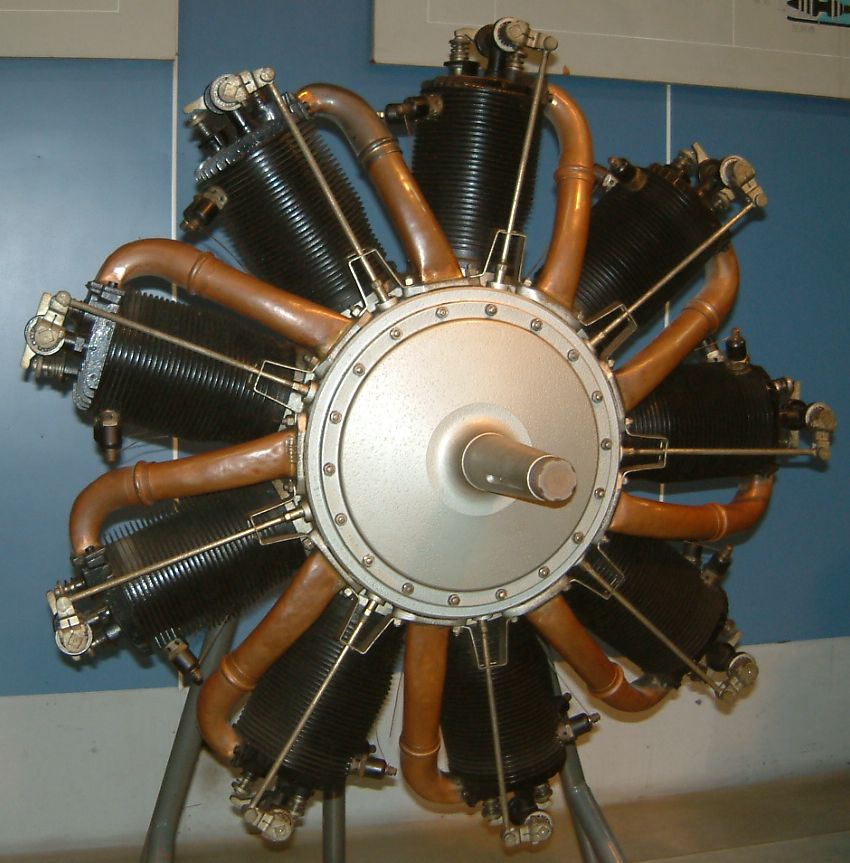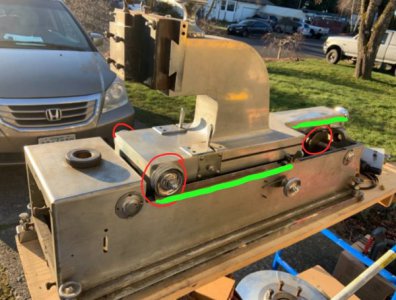-
Welcome back Guest! Did you know you can mentor other members here at H-M? If not, please check out our Relaunch of Hobby Machinist Mentoring Program!
You are using an out of date browser. It may not display this or other websites correctly.
You should upgrade or use an alternative browser.
You should upgrade or use an alternative browser.
This one has me stumped, what is it?
- Thread starter JimDawson
- Start date
- Joined
- Jan 28, 2011
- Messages
- 3,485
Perhaps just a typo?Car engines oft run above 10000 and aircraft around 7500-8000
Cheers Phil
Nope not a typo. The whole ROTARY engine spins while the crankshaft is fixed to the firewall and the prop is attached to the engine case. With the huge gyroscopic forces on the engine casing the engines were limited to about 1200-1300 rpm. By the end of WW1 the top rpm had increased to 2000 rpm. This engine design was abandoned as better RADIAL and in-line designs were being built that could produce better power to weight ratios.

Rotary engine - Wikipedia
Mazda made the Wankel, which was the opposite to the rotary, the trilob cylinder spins and the engine case is stationary.
Formula 1 engines recently were spinning at 18000 rpm, but unlike our regular production based NASCAR engine for example, they use lots of oil as the clearances are very loose. Street engines may have .002-.003” piston to cylinder wall, the F1 engines are 2-3 times that.
- Joined
- Feb 9, 2017
- Messages
- 5,249
???? I've never owned a OEM car with a redline of 10,000rpm, but the highest performance car was MBZ 320CLK and it redlined at 7,500 IIRC.Perhaps just a typo?Car engines oft run above 10000 and aircraft around 7500-8000
Cheers Phil
The aircraft I'm most familiar with were WWII inline and radial engines and very few operated above 3,000rpm, most at 2,500-2,700 rpm. Even with gear reduction. Reason being over a certain rpm the prop tips broke the speed of sound and lost efficiency. Almost all used superchargers too so rpm was tied to boost and would damage the engine if running to high rpm/boost for too long. The Continental and Lycoming engines used in civilian aircraft don't operate above 3,000rpm either IIRC.
- Joined
- Jul 2, 2014
- Messages
- 7,594
It is not a typo, Phil. That was in the early days of internal combustion engines, designs were simple and crude, and materials were nothing like today. Even today, with a common Lycoming or Continental engine in small airplanes, the maximum speed is about 2500 to 2700 rpm. Much of the reason for it is the propeller. If the engine turns faster than that, the propeller tips will start to go supersonic, which causes huge amounts of drag. The cure is a geared output shaft (some actually have run the propellor off the camshaft), but that adds complication, cost, weight, and more things that can fail. The four major attributes of a successful aircraft engine are reliability, reliability, and reliability, followed by light weight.Perhaps just a typo?Car engines oft run above 10000 and aircraft around 7500-8000
Cheers Phil
The average automobile engine today tops out at around 6000-7000 rpm. To see 10000 rpm you will be mostly looking at motorcycles or race cars, exotic cars, or models.
Maximum rpm of a model T Ford engine from the same era as the rotary engine was 1850 rpm.
Model T Ford Forum: RPM
www.mtfca.com
Last edited:
- Joined
- Feb 2, 2013
- Messages
- 3,627
looks like a strange specialty vertical latheThis being advertised as a ''Metal Lave'', so obviously the seller has no idea what it is either. Any ideas?
possibly a strange planer???
Valve adjustment a pain too...Fiat X-19. Pull the engine to set the timing....and just to add to the fun it was common for the distributor hold down to come loose....
Robert
Sent from my SAMSUNG-SM-G930A using Tapatalk
- Joined
- Feb 9, 2017
- Messages
- 5,249
looks like a strange specialty vertical lathe
possibly a strange planer???
Could be, but the pics are next to worthless. I've seen time and again on CL when the person is clueless their pics are just as clueless. They don't know what to focus on I think. I think it sat 90deg to some kind of line that went through where "head" is sitting in the pic. Because like has been noted, the cheap roller that looks like one off a roller conveyer, doesn't look like it was meant to be moved back and forth all the time. There are hints of some kind of pulley's on the far end inside. But why it only seems to have three cheap rollers doesn't seem overly steady or sturdy. Wonder if it would make any more sense in person? I'd love to see what the different pieces are made out of.
- Joined
- Dec 9, 2016
- Messages
- 1,133
- Joined
- Apr 23, 2018
- Messages
- 6,533
I think it is indeed a vertical lathe. The hint is the flywheel below it... it could be a flywheel and disc rotor surfacing lathe. Put work on the table like loading an EP record into a turntable, put a tool in a fixture like a shaper, and feed. Maybe...


